2017 Peugeot 3008 Hybrid 4 roof
[x] Cancel search: roofPage 139 of 578
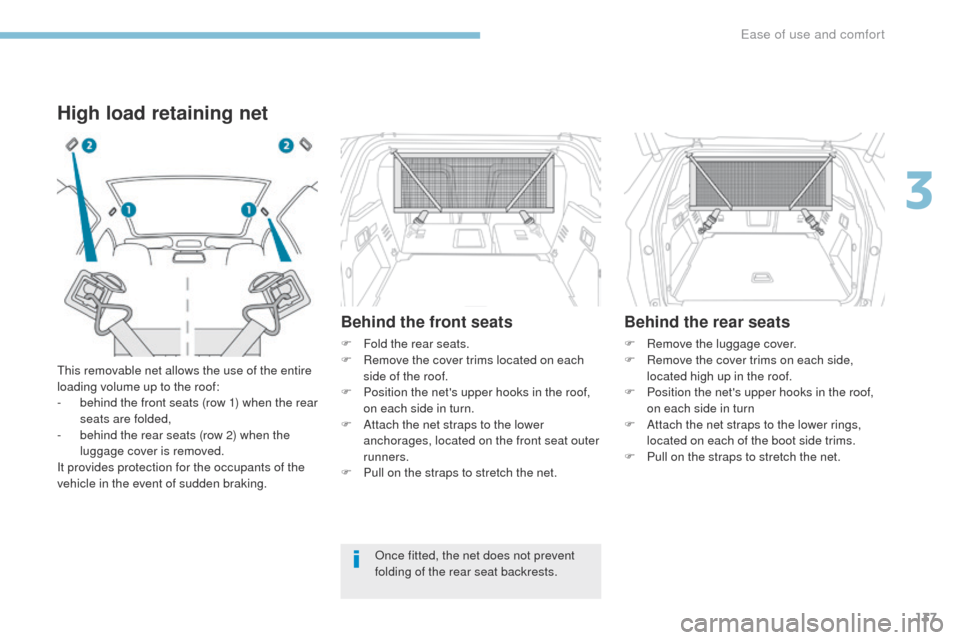
137
3008-2_en_Chap03_ergonomie-et-confort_ed01-2016
High load retaining net
This removable net allows the use of the entire
loading volume up to the roof:
-
b
ehind the front seats (row 1) when the rear
seats are folded,
-
b
ehind the rear seats (row 2) when the
luggage cover is removed.
It provides protection for the occupants of the
vehicle in the event of sudden braking.
Behind the front seats
F Fold the rear seats.
F R emove the cover trims located on each
side of the roof.
F
P
osition the net's upper hooks in the roof,
on each side in turn.
F
A
ttach the net straps to the lower
anchorages, located on the front seat outer
runners.
F
P
ull on the straps to stretch the net.
Behind the rear seats
F Remove the luggage cover.
F R emove the cover trims on each side,
located high up in the roof.
F
P
osition the net's upper hooks in the roof,
on each side in turn
F
A
ttach the net straps to the lower rings,
located on each of the boot side trims.
F
P
ull on the straps to stretch the net.
Once fitted, the net does not prevent
folding of the rear seat backrests.
3
Ease of use and comfort
Page 178 of 578
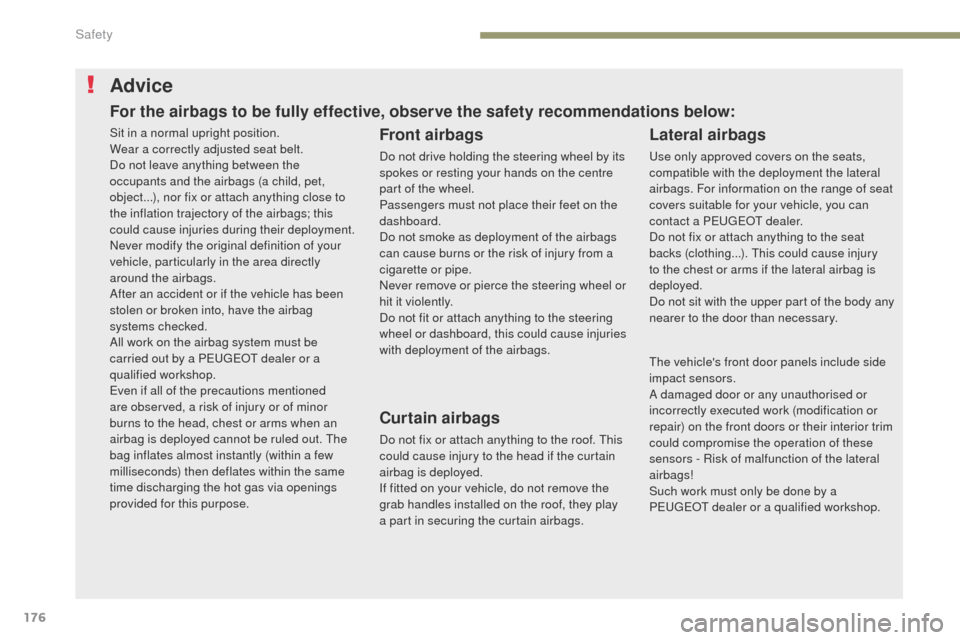
176
3008-2_en_Chap05_securite_ed01-2016
Advice
Front airbags
Do not drive holding the steering wheel by its
spokes or resting your hands on the centre
part of the wheel.
Passengers must not place their feet on the
dashboard.
Do not smoke as deployment of the airbags
can cause burns or the risk of injury from a
cigarette or pipe.
Never remove or pierce the steering wheel or
hit it violently.
Do not fit or attach anything to the steering
wheel or dashboard, this could cause injuries
with deployment of the airbags.
Lateral airbags
Use only approved covers on the seats,
compatible with the deployment the lateral
airbags. For information on the range of seat
covers suitable for your vehicle, you can
contact a PEUGEOT dealer.
Do not fix or attach anything to the seat
backs (clothing...). This could cause injury
to the chest or arms if the lateral airbag is
deployed.
Do not sit with the upper part of the body any
nearer to the door than necessary.
Curtain airbags
Do not fix or attach anything to the roof. This
could cause injury to the head if the curtain
airbag is deployed.
If fitted on your vehicle, do not remove the
grab handles installed on the roof, they play
a part in securing the curtain airbags.
Sit in a normal upright position.
Wear a correctly adjusted seat belt.
Do not leave anything between the
occupants and the airbags (a child, pet,
object...), nor fix or attach anything close to
the inflation trajectory of the airbags; this
could cause injuries during their deployment.
Never modify the original definition of your
vehicle, particularly in the area directly
around the airbags.
After an accident or if the vehicle has been
stolen or broken into, have the airbag
systems checked.
All work on the airbag system must be
carried out by a PEUGEOT dealer or a
qualified workshop.
Even if all of the precautions mentioned
are observed, a risk of injury or of minor
burns to the head, chest or arms when an
airbag is deployed cannot be ruled out. The
bag inflates almost instantly (within a few
milliseconds) then deflates within the same
time discharging the hot gas via openings
provided for this purpose.
For the airbags to be fully effective, observe the safety recommendations below:
The vehicle's front door panels include side
impact sensors.
A damaged door or any unauthorised or
incorrectly executed work (modification or
repair) on the front doors or their interior trim
could compromise the operation of these
sensors - Risk of malfunction of the lateral
airbags!
Such work must only be done by a
PEUGEOT dealer or a qualified workshop.
Safety
Page 250 of 578
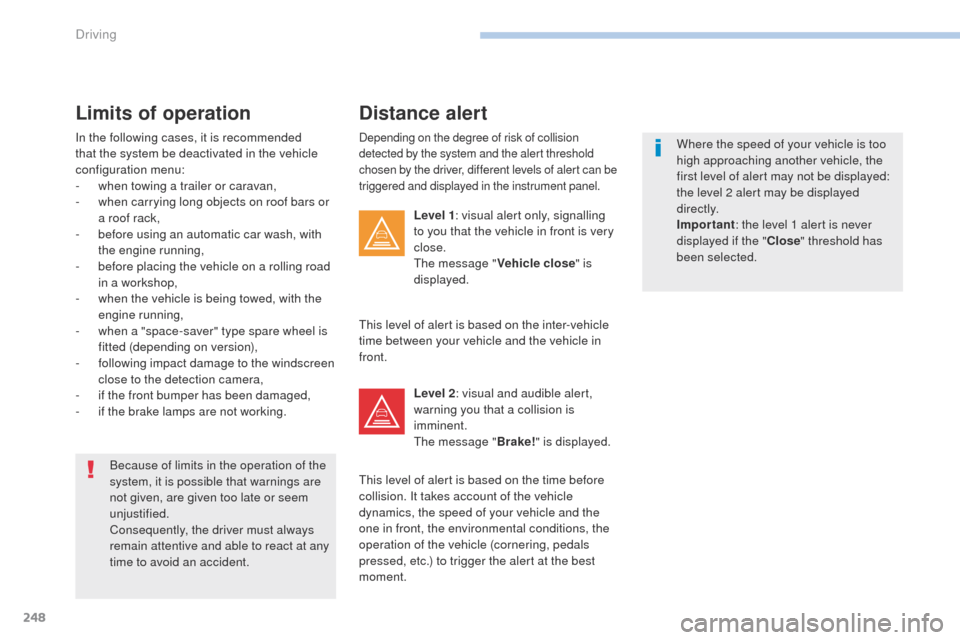
248
3008-2_en_Chap06_conduite_ed01-2016
Depending on the degree of risk of collision
detected by the system and the alert threshold
chosen by the driver, different levels of alert can be
triggered and displayed in the instrument panel.
Because of limits in the operation of the
system, it is possible that warnings are
not given, are given too late or seem
unjustified.
Consequently, the driver must always
remain attentive and able to react at any
time to avoid an accident.
Distance alert
Level 1: visual alert only, signalling
to you that the vehicle in front is very
close.
The message " Vehicle close" is
displayed.
Limits of operation
In the following cases, it is recommended
that the system be deactivated in the vehicle
configuration menu:
-
w
hen towing a trailer or caravan,
-
w
hen carrying long objects on roof bars or
a roof rack,
-
b
efore using an automatic car wash, with
the engine running,
-
b
efore placing the vehicle on a rolling road
in a workshop,
-
w
hen the vehicle is being towed, with the
engine running,
-
w
hen a "space-saver" type spare wheel is
fitted (depending on version),
-
f
ollowing impact damage to the windscreen
close to the detection camera,
-
i
f the front bumper has been damaged,
-
i
f the brake lamps are not working. This level of alert is based on the inter-vehicle
time between your vehicle and the vehicle in
front.
Level 2: visual and audible alert,
warning you that a collision is
imminent.
The message " Brake!" is displayed.
This level of alert is based on the time before
collision. It takes account of the vehicle
dynamics, the speed of your vehicle and the
one in front, the environmental conditions, the
operation of the vehicle (cornering, pedals
pressed, etc.) to trigger the alert at the best
moment. Where the speed of your vehicle is too
high approaching another vehicle, the
first level of alert may not be displayed:
the level 2 alert may be displayed
di r e c t l y.
Important
: the level 1 alert is never
displayed if the " Close" threshold has
been selected.
Driving
Page 253 of 578
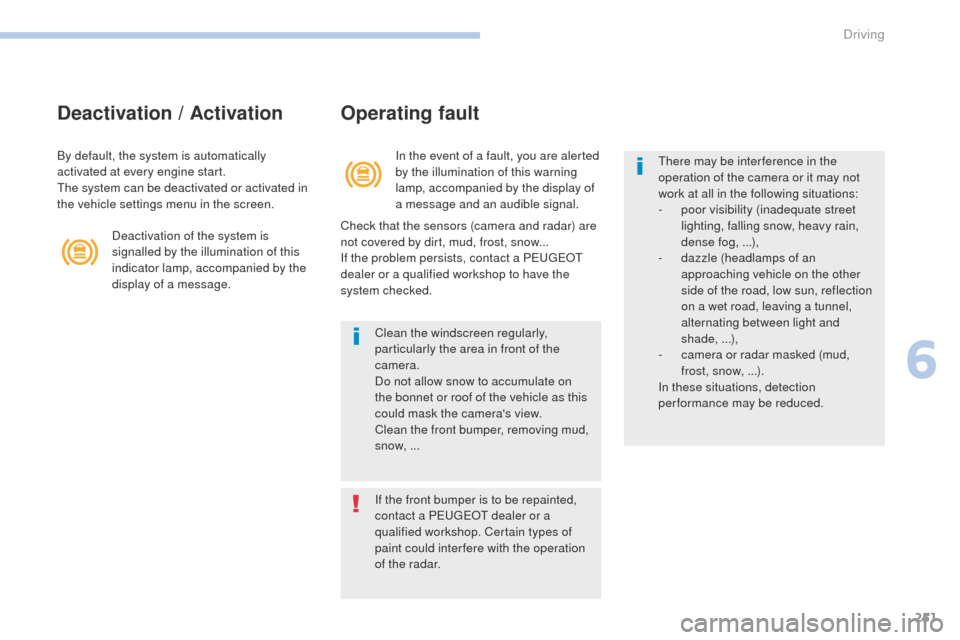
251
3008-2_en_Chap06_conduite_ed01-2016
Deactivation / ActivationOperating fault
In the event of a fault, you are alerted
by the illumination of this warning
lamp, accompanied by the display of
a message and an audible signal.
Clean the windscreen regularly,
particularly the area in front of the
camera.
Do not allow snow to accumulate on
the bonnet or roof of the vehicle as this
could mask the camera's view.
Clean the front bumper, removing mud,
snow, ...
If the front bumper is to be repainted,
contact a PEUGEOT dealer or a
qualified workshop. Certain types of
paint could inter fere with the operation
of the radar.
Check that the sensors (camera and radar) are
not covered by dirt, mud, frost, snow...
If the problem persists, contact a PEUGEOT
dealer or a qualified workshop to have the
system checked.
By default, the system is automatically
activated at every engine start.
The system can be deactivated or activated in
the vehicle settings menu in the screen.
Deactivation of the system is
signalled by the illumination of this
indicator lamp, accompanied by the
display of a message. There may be interference in the
operation of the camera or it may not
work at all in the following situations:
-
p
oor visibility (inadequate street
lighting, falling snow, heavy rain,
dense fog, ...),
-
d
azzle (headlamps of an
approaching vehicle on the other
side of the road, low sun, reflection
on a wet road, leaving a tunnel,
alternating between light and
shade, ...),
-
c
amera or radar masked (mud,
frost, snow, ...).
In these situations, detection
performance may be reduced.
6
Driving
Page 281 of 578
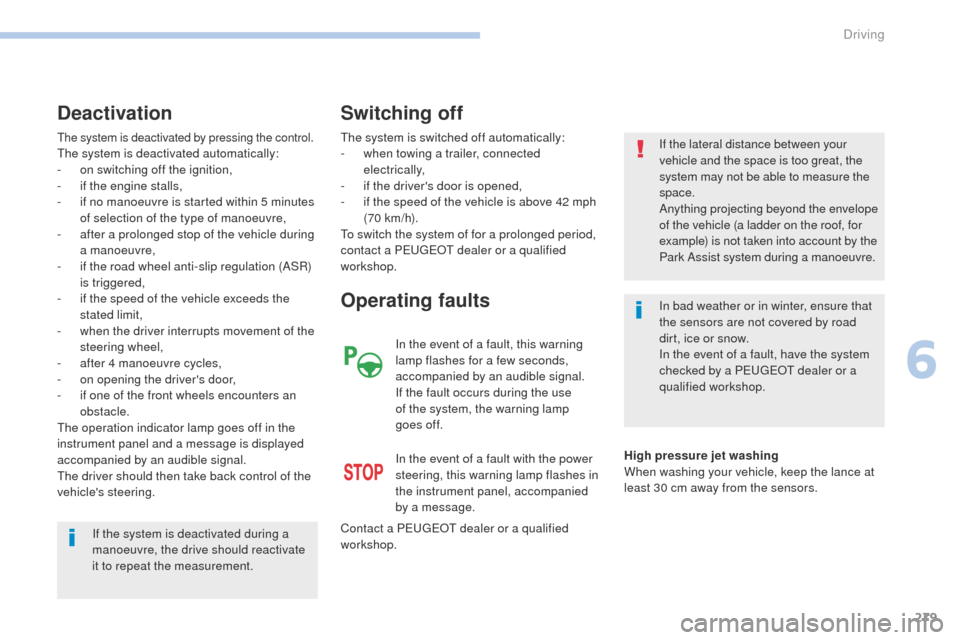
279
3008-2_en_Chap06_conduite_ed01-2016
The system is deactivated by pressing the control.The system is deactivated automatically:
- o n switching off the ignition,
-
i
f the engine stalls,
-
i
f no manoeuvre is started within 5 minutes
of selection of the type of manoeuvre,
-
a
fter a prolonged stop of the vehicle during
a manoeuvre,
-
i
f the road wheel anti-slip regulation (ASR)
is triggered,
-
i
f the speed of the vehicle exceeds the
stated limit,
-
w
hen the driver interrupts movement of the
steering wheel,
-
a
fter 4 manoeuvre cycles,
-
o
n opening the driver's door,
-
i
f one of the front wheels encounters an
obstacle.
The operation indicator lamp goes off in the
instrument panel and a message is displayed
accompanied by an audible signal.
The driver should then take back control of the
vehicle's steering.
Deactivation
The system is switched off automatically:
- w hen towing a trailer, connected
electrically,
-
i
f the driver's door is opened,
-
i
f the speed of the vehicle is above 42 mph
(70 km/h).
To switch the system of for a prolonged period,
contact a PEUGEOT dealer or a qualified
workshop.
Operating faults
In the event of a fault with the power
steering, this warning lamp flashes in
the instrument panel, accompanied
by a message.
Contact a PEUGEOT dealer or a qualified
workshop.
Switching off
If the lateral distance between your
vehicle and the space is too great, the
system may not be able to measure the
space.
Anything projecting beyond the envelope
of the vehicle (a ladder on the roof, for
example) is not taken into account by the
Park Assist system during a manoeuvre.
In bad weather or in winter, ensure that
the sensors are not covered by road
dirt, ice or snow.
In the event of a fault, have the system
checked by a PEUGEOT dealer or a
qualified workshop.
If the system is deactivated during a
manoeuvre, the drive should reactivate
it to repeat the measurement. In the event of a fault, this warning
lamp flashes for a few seconds,
accompanied by an audible signal.
If the fault occurs during the use
of the system, the warning lamp
goes
off. High pressure jet washing
When washing your vehicle, keep the lance at
least 30 cm away from the sensors.
6
Driving
Page 295 of 578
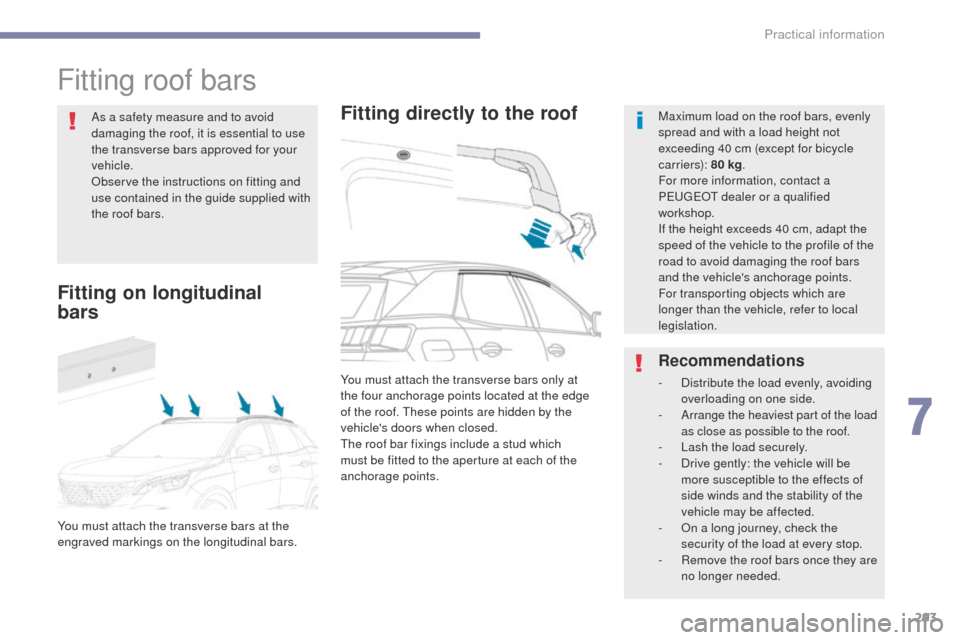
293
3008-2_en_Chap07_infos-pratiques_ed01-2016
Fitting roof bars
Fitting directly to the roofMaximum load on the roof bars, evenly
spread and with a load height not
exceeding 40 cm (except for bicycle
c a r r i e r s): 80 kg.
For more information, contact a
PEUGEOT dealer or a qualified
workshop.
If the height exceeds 40 cm, adapt the
speed of the vehicle to the profile of the
road to avoid damaging the roof bars
and the vehicle's anchorage points.
For transporting objects which are
longer than the vehicle, refer to local
legislation.
Recommendations
- Distribute the load evenly, avoiding overloading on one side.
-
A
rrange the heaviest part of the load
as close as possible to the roof.
-
L
ash the load securely.
-
D
rive gently: the vehicle will be
more susceptible to the effects of
side winds and the stability of the
vehicle may be affected.
-
O
n a long journey, check the
security of the load at every stop.
-
R
emove the roof bars once they are
no longer needed.
As a safety measure and to avoid
damaging the roof, it is essential to use
the transverse bars approved for your
vehicle.
Observe the instructions on fitting and
use contained in the guide supplied with
the roof bars.
You must attach the transverse bars only at
the four anchorage points located at the edge
of the roof. These points are hidden by the
vehicle's doors when closed.
The roof bar fixings include a stud which
must be fitted to the aperture at each of the
anchorage points.
Fitting on longitudinal
bars
You must attach the transverse bars at the
engraved markings on the longitudinal bars.
7
Practical information
Page 337 of 578
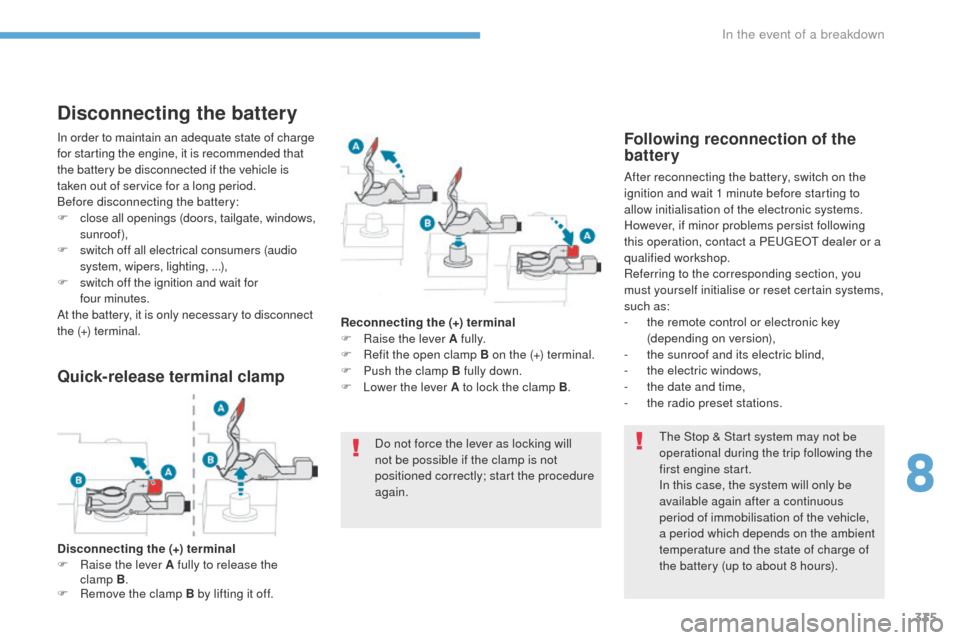
335
3008-2_en_Chap08_en cas-de-panne_ed01-2016
Disconnecting the battery
The Stop & Start system may not be
operational during the trip following the
first engine start.
In this case, the system will only be
available again after a continuous
period of immobilisation of the vehicle,
a period which depends on the ambient
temperature and the state of charge of
the battery (up to about 8 hours).
In order to maintain an adequate state of charge
for starting the engine, it is recommended that
the battery be disconnected if the vehicle is
taken out of service for a long period.
Before disconnecting the battery:
F
c
lose all openings (doors, tailgate, windows,
sunroof),
F
s
witch off all electrical consumers (audio
system, wipers, lighting, ...),
F
s
witch off the ignition and wait for
four
minutes.
At the battery, it is only necessary to disconnect
the (+) terminal.
Following reconnection of the
battery
After reconnecting the battery, switch on the
ignition and wait 1 minute before starting to
allow initialisation of the electronic systems.
However, if minor problems persist following
this operation, contact a PEUGEOT dealer or a
qualified workshop.
Referring to the corresponding section, you
must yourself initialise or reset certain systems,
such as:
-
t
he remote control or electronic key
(depending on version),
-
t
he sunroof and its electric blind,
-
t
he electric windows,
-
t
he date and time,
-
t
he radio preset stations.
Quick-release terminal clamp
Disconnecting the (+) terminal
F Ra ise the lever A fully to release the
clamp
B.
F
R
emove the clamp B by lifting it off. Reconnecting the (+) terminal
F
Ra
ise the lever A fully.
F
R
efit the open clamp B on the (+) terminal.
F
P
ush the clamp B fully down.
F
L
ower the lever A to lock the clamp B
.
Do not force the lever as locking will
not be possible if the clamp is not
positioned correctly; start the procedure
again.
8
In the event of a breakdown
Page 349 of 578

347
3008-2_en_Chap11_index-alpha_ed01-2016
Demisting ......................................................11 6
Demisting, front ............................................. 11 6
Demisting, rear
.............................................. 11
8
Demisting, rear screen
.................................118
Dials and gauges
............................................ 12
Dimensions
................................................... 344
Dipstick
................
.................................... 36, 297
Direction indicators
..............14 4, 323 , 324, 328
Display screen, instrument panel
...............................
..........218
Distance alert
............................ 21, 26 , 247 , 248
Door pockets
................................................. 11
9
Doors
............................................................... 74
Doors, rear
.................................................... 19 4
Driver’s attention warning
...............................
........................253
Driving
............................................................. 88
Driving abroad ............................................... 143
Driving economically ....................................... 10
Driving positions (storing)
...............................96
Driving time warning
..................................... 252
Dynamic pack
..............................
.................217
Dynamic stability control (DSC)
................................... 26, 160 , 162, 16 4 Emergency switching off ...............................
2 02
Emergency warning lamps ................... 15
7, 307
Emissions control system, SCR
..............................................................31
Energy economy mode
.................................290
Engine compartment
...........................295, 296
Engine, Diesel
...................... 28
3, 296 , 308 , 340
Engine, petrol
...............................283, 295 , 338
Engines
................................................338, 340
Environment
...............................
...............10, 63
Child seats
.............
17
1
, 17 7 , 178 , 182-18 4 , 192
Child seats, conventional
...................... 183, 18 4
Child seats, i-Size
...............................
.......... 19 0
Child seats, ISOFIX
...................... 18
6 -188 , 19 0
Cigarette lighter ............................................. 120
Closing the boot
............................ 56, 61 , 62 , 75
Closing the doors
.......................... 56, 60-62 , 74
Configuration, vehicle
........................ 45, 48 , 50
Control, emergency boot release
.................................................. 81
Control, emergency door
................................ 64
Control, heated seats
...................................... 97
Controls, steering mounted
.......................... 2 11
Control stalk, lighting
....................... 17,
141 , 14 4
Control stalk, wipers
..................... 152, 153 , 155
Courtesy lamps
............................................. 128
Cover, load space
......................................... 13
6
Cruise control
....................... 2
26 , 229 , 234 , 238
Cruise control by speed limit recognition
.......................................... 229
Cruise control, dynamic with Stop function
.............................. 229, 238
Cup holder
...............................
...................... 11 9
F
Fatigue detection .................................. 252, 253
Filling the fuel tank ................................. 28
1-283
Filter, air
...............
......................................... 301
Filter, Diesel fuel
........................................... 296
Filter, oil
......................................................... 301
Filter, particle
....................................... 300, 301
Filter, passenger compartment
.............................................. 3
01
Fitting a wheel
...............................
................319
Fitting roof bars
............................................. 293
Fittings, boot
................................................. 13
5
Fittings, interior
..................................... 11 9, 120
Fittings, rear
...............................
...................13 3
Flap, fuel filler
...............................
.........281, 282
Flashing indicators
................................ 14 4, 324
Floor, boot, adjustable
..................................13 8
Foglamps
...................................................... 142
Foglamps, front
.............142, 151 , 323 , 324, 326
Foglamps, rear
...................................... 142, 329
Folding the rear seats
...................................13 0
D
Date (setting) ............................... ....................45
Daytime running lamps .................143, 323 , 324
Deactivating the passenger airbag
.......................................................... 17
3
Deadlocking
.............................................. 56, 62
Defrosting
.............................................. 11 6, 118
Defrosting, front
............................................ 11
6E
Eco-driving (advice) ........................................ 10
Economy mode ............................................. 290
Electronic brake force distribution (EBFD)
................................................ 160, 161
Emergency braking assistance (EBA)
.......... 16
0
Emergency call
............................................. 15
8
.
Alphabetical index